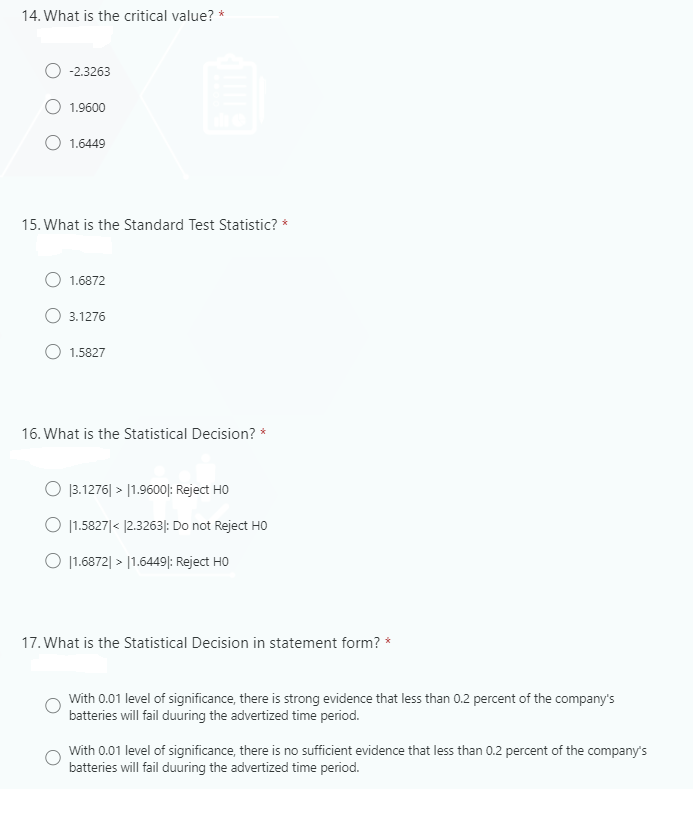The advertised claim for batteries for cell phones is set at 48 operating hours with proper charging procedures. A study of 5000 batteries is carried out and 15 stop operating prior to 48 hours. Do these experimental results support the claim that less than 0.2 percent of the company's batteries will fail during the advertised time period, with proper charging procedures? Use a hypothesis-testing procedure with a = 0.01.
The advertised claim for batteries for cell phones is set at 48 operating hours with proper charging procedures. A study of 5000 batteries is carried out and 15 stop operating prior to 48 hours. Do these experimental results support the claim that less than 0.2 percent of the company's batteries will fail during the advertised time period, with proper charging procedures? Use a hypothesis-testing procedure with a = 0.01.
MATLAB: An Introduction with Applications
6th Edition
ISBN:9781119256830
Author:Amos Gilat
Publisher:Amos Gilat
Chapter1: Starting With Matlab
Section: Chapter Questions
Problem 1P
Related questions
Question
PLS ANSWER

Transcribed Image Text:14. What is the critical value? *
-2.3263
1.9600
O 1.6449
15. What is the Standard Test Statistic? *
1.6872
O 3.1276
1.5827
16. What is the Statistical Decision? *
O 13.1276| > |1.9600|: Reject HO
O 1.5827|< |2.3263|: Do not Reject HO
O 1.6872| > |1.6449|: Reject HO
17. What is the Statistical Decision in statement form? *
With 0.01 level of significance, there is strong evidence that less than 0.2 percent of the company's
batteries will fail duuring the advertized time period.
With 0.01 level of significance, there is no sufficient evidence that less than 0.2 percent of the company's
batteries will fail duuring the advertized time period.

Transcribed Image Text:The advertised claim for batteries for cell phones is set at 48 operating hours with proper charging procedures. A study of
5000 batteries is carried out and 15 stop operating prior to 48 hours. Do these experimental results support the claim
that less than 0.2 percent of the company's batteries will fail during the advertised time period, with proper charging
procedures? Use a hypothesis-testing procedure with a = 0.01.
Expert Solution
This question has been solved!
Explore an expertly crafted, step-by-step solution for a thorough understanding of key concepts.
Step by step
Solved in 2 steps

Recommended textbooks for you

MATLAB: An Introduction with Applications
Statistics
ISBN:
9781119256830
Author:
Amos Gilat
Publisher:
John Wiley & Sons Inc

Probability and Statistics for Engineering and th…
Statistics
ISBN:
9781305251809
Author:
Jay L. Devore
Publisher:
Cengage Learning

Statistics for The Behavioral Sciences (MindTap C…
Statistics
ISBN:
9781305504912
Author:
Frederick J Gravetter, Larry B. Wallnau
Publisher:
Cengage Learning

MATLAB: An Introduction with Applications
Statistics
ISBN:
9781119256830
Author:
Amos Gilat
Publisher:
John Wiley & Sons Inc

Probability and Statistics for Engineering and th…
Statistics
ISBN:
9781305251809
Author:
Jay L. Devore
Publisher:
Cengage Learning

Statistics for The Behavioral Sciences (MindTap C…
Statistics
ISBN:
9781305504912
Author:
Frederick J Gravetter, Larry B. Wallnau
Publisher:
Cengage Learning

Elementary Statistics: Picturing the World (7th E…
Statistics
ISBN:
9780134683416
Author:
Ron Larson, Betsy Farber
Publisher:
PEARSON

The Basic Practice of Statistics
Statistics
ISBN:
9781319042578
Author:
David S. Moore, William I. Notz, Michael A. Fligner
Publisher:
W. H. Freeman

Introduction to the Practice of Statistics
Statistics
ISBN:
9781319013387
Author:
David S. Moore, George P. McCabe, Bruce A. Craig
Publisher:
W. H. Freeman